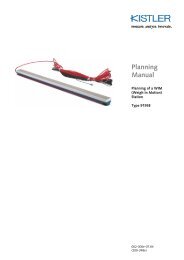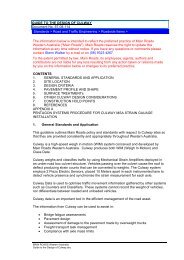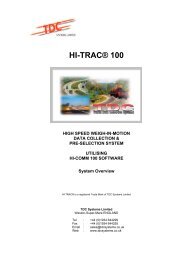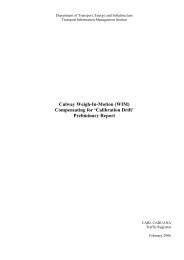AP-G84/04 Best practice in road use data collection, analysis ... - WIM
AP-G84/04 Best practice in road use data collection, analysis ... - WIM
AP-G84/04 Best practice in road use data collection, analysis ... - WIM
Create successful ePaper yourself
Turn your PDF publications into a flip-book with our unique Google optimized e-Paper software.
Accessed by AR - ARRB TRANSPORT RESEARCH on <strong>04</strong> Feb 2005<br />
5 DATA INTEGRATION<br />
Aust<strong>road</strong>s 20<strong>04</strong><br />
— 33 —<br />
<strong>Best</strong> Practices <strong>in</strong> Road Use Data Collection, Analysis and Report<strong>in</strong>g<br />
Road authorities are <strong>in</strong>creas<strong>in</strong>gly <strong>in</strong>volved <strong>in</strong> collect<strong>in</strong>g a wide range of <strong>road</strong> <strong>use</strong> <strong>data</strong>. These <strong>data</strong><br />
types can come from a number of sources. There is also an <strong>in</strong>creas<strong>in</strong>g need to efficiently access<br />
the <strong>data</strong> with<strong>in</strong> a RA, or from external parties <strong>in</strong>clud<strong>in</strong>g the public. This raises the issue that <strong>road</strong><br />
<strong>use</strong> <strong>data</strong> should be better <strong>in</strong>tegrated for easy access. This section describes the issues <strong>in</strong>volved,<br />
current <strong>practice</strong>s with<strong>in</strong> RAs and future directions.<br />
Data <strong>in</strong>tegration can be b<strong>road</strong>ly def<strong>in</strong>ed as the br<strong>in</strong>g<strong>in</strong>g together of different types of <strong>road</strong> <strong>use</strong> <strong>data</strong><br />
and other <strong>road</strong> <strong>data</strong> such as the <strong>in</strong>ventory of <strong>road</strong> conditions <strong>in</strong> a central <strong>data</strong>base. The <strong>in</strong>tegration<br />
can utilise several <strong>data</strong>bases, with the capability of referenc<strong>in</strong>g the <strong>data</strong> us<strong>in</strong>g a unique referenc<strong>in</strong>g<br />
system such as <strong>road</strong> numbers and Geographical Information System (GIS) coord<strong>in</strong>ates.<br />
By comb<strong>in</strong><strong>in</strong>g <strong>data</strong>, it is possible to generate further <strong>in</strong>formation than <strong>in</strong> its parts, e.g. the Aust<strong>road</strong>s<br />
(2001) National Performance Indicators Program. However, <strong>in</strong>tegration should not be <strong>in</strong>terpreted<br />
as a simple comb<strong>in</strong>ation of <strong>data</strong> such as averag<strong>in</strong>g <strong>data</strong> sets, merg<strong>in</strong>g <strong>data</strong> from different time<br />
periods of a day or aggregat<strong>in</strong>g <strong>data</strong> across lanes. Also, raw <strong>data</strong> should be ma<strong>in</strong>ta<strong>in</strong>ed <strong>in</strong> a<br />
<strong>data</strong>base as far as possible.<br />
5.1 Road Use Data Types for Integration<br />
The range of <strong>road</strong> <strong>use</strong> and related <strong>data</strong> generally suitable for <strong>in</strong>tegration, and reflect<strong>in</strong>g the<br />
diversity of traffic <strong>in</strong>formation needs, <strong>in</strong>cludes the follow<strong>in</strong>g:<br />
Traffic volumes, traffic composition (i.e. classified counts) and turn<strong>in</strong>g movement counts;<br />
Pavement load<strong>in</strong>g <strong>data</strong> from weigh-<strong>in</strong>-motion (<strong>WIM</strong>) systems and weigh bridges;<br />
Pavement condition rat<strong>in</strong>g;<br />
Transport demand <strong>data</strong> such as orig<strong>in</strong>-dest<strong>in</strong>ation <strong>data</strong>;<br />
Route performance <strong>data</strong>, e.g. travel time, level of service or congestion <strong>in</strong>dex;<br />
Traffic management <strong>data</strong> from ITS, signal systems or freeway management systems,<br />
Road crash <strong>data</strong>, e.g. exposure measure, risk or black spots; and<br />
Asset management <strong>data</strong> such as bridges, tunnels, signs and mark<strong>in</strong>gs and guard rails.<br />
The above list is not exhaustive and other <strong>data</strong> types can be <strong>in</strong>cluded <strong>in</strong> an <strong>in</strong>tegrated <strong>data</strong>base<br />
now and <strong>in</strong> the future. Various RAs have already started the <strong>in</strong>tegration process, although there<br />
are no standard procedures, software or types of <strong>data</strong> for <strong>in</strong>tegration. Efficient access us<strong>in</strong>g<br />
<strong>data</strong>base technologies will benefit a wide range of <strong>use</strong>rs with<strong>in</strong> and external to a jurisdiction for<br />
many different needs. An example is the need for a <strong>road</strong> crash exposure <strong>in</strong>dicator and one that<br />
can correlate with <strong>road</strong> crashes already stored <strong>in</strong>, say, a GIS framework. For urban <strong>road</strong>s, that<br />
exposure <strong>in</strong>dicator can be a low-cost <strong>in</strong>dicator available from <strong>road</strong> traffic counts <strong>in</strong> a signal control<br />
system, assum<strong>in</strong>g that signal counts are stored rout<strong>in</strong>ely.<br />
Figure 9 shows the framework of the ARMIS <strong>data</strong>base of the Queensland Department of Ma<strong>in</strong><br />
Roads. The ARMIS framework covers most of the <strong>data</strong> types mentioned above, supplemented with<br />
<strong>road</strong> and bridge <strong>in</strong>ventory <strong>data</strong>. These <strong>data</strong> types are entered <strong>in</strong>to a <strong>data</strong>base, which has an audit<br />
utility. At the core of the <strong>data</strong>base is a <strong>road</strong> reference and <strong>road</strong> <strong>in</strong>ventory that specifies locations for<br />
traffic <strong>analysis</strong>, <strong>road</strong> crash <strong>analysis</strong>, pavement condition, <strong>road</strong> ma<strong>in</strong>tenance performance contracts<br />
and construction management. After an audit<strong>in</strong>g process, the <strong>data</strong> is sent to the Road Information<br />
Data Centre to support a wide range of <strong>road</strong> <strong>data</strong> <strong>use</strong>rs.

















